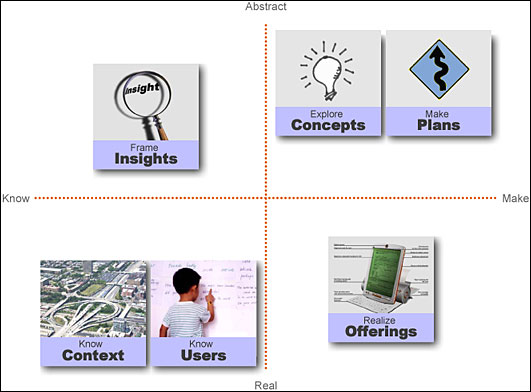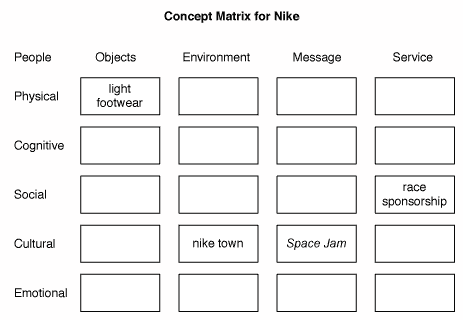« (Side thought on AIGA's Power of Design) | Main | About With and For Part 3: Students Say The Darnedest Things! »
October 26, 2003
About With and For Part 2: Vijay's Talk
The meat of the conference were eight presentations given by various design professionals. Unfortunately, there were only two time slots, which means four talks took place concurrently. Choosing was not easy.
The first session I went to was lead by Vijay Kumar, a professor at ID. I went because all of the ID students I met love him. They say he's a great, fun, smart, friendly teacher. From what I saw, I concur.
The other thing to know about Vijay is that he resides in a world of frameworks. He loves models. It seems he has not met a matrix he didn't like.
His talk, Insights to Innovations (not yet online), addressed the steps designers take to get from insights derived from research, to concepts that drive new product ideas. Vijay has a delightfully simple two-by-two that represents the steps in a design process:

You start in the lower left-hand corner, getting to "know" the "real" - users and their contexts. Then you move up, abstracting from that knowledge to frame insights. Then you progress from knowing to making abstractions -- concepts and plans. And then you end up by producing something tangible. In a more standard framework, the quadrants would read, clockwise from lower left, Research, Analysis, Synthesis, and Implement.
I don't know how useful this framework is, but I'm a fan of it. A smart encapsulation of what we go through.
The bulk of Vijay's talk was about how we cross the threshold from insights to concepts. From analysis to synthesis. He claimed there are four modes for bridging this gap:
Criteria can be thought of simple noun phrases that emerge from an insight process. The classic example of this (and one which you'll hear ad nauseum if you spend any time at ID), are Oxo Good Grips. You can think of the Good Grips line as a series of physical properties -- large handles, rubber handles, ovoid shape (so they don't rotate in your hand), large clear type, etc. etc.-- that support ease of use for people with motor or perceptual challenges.
Principles are verb phrases that address are like sentences in a mission statement for the product. The example used came from a student project for a museum (the Museum of Science and Industry, I believe). From the research, the museum developed a set of principles: 1) Provide real and tailored visitor experiences, 2) Extend access to the museum experiences, 3) Foster a culture of innovation.
Frameworks are a bit more complex. They tend to be grids, matrices, any kind of system that identifies key attributes and highlights opportunities. One framework currently under development at ID is the Concept Matrix:

The Concept Matrix is known for it's POEMS mnemonic across the top. Down the left side are five factors of people. The matrix can be helpful to companies identify opportunities...

(Vijay had more stuff in boxes, but I didn't get it all down... I'm still not quite sure I buy the Concept Matrix...)
The last are scenarios, which might be the most basic. What stories can we tell, based on what we know about users and their contexts, that suggest ways of addressing their needs and desires? What are people's key factors and driving forces? What makes sense in terms of supporting those factors and forces? (I love the idea of writing as design method, and I just need to remember to do it more often.)
What I liked about Vijay's talk is it presented a series of ideas in a cogent fashion that allows someone like me to see "where I fit", and to consider, "Where could I go? What am I not taking advantage of?"
Posted by peterme at October 26, 2003 01:53 PM
Trackback Pings
TrackBack URL for this entry:
http://www.peterme.com/mt/mt-tb.cgi/208
Listed below are links to weblogs that reference About With and For Part 2: Vijay's Talk:
» Steps in a design process from Column Two
This is from a while back, but it was just raised as part of a discussion on the AIfIA list: Peter Merholz blogged a diagram from Vijay Kumar that describes the steps in a design process. To quote: You start... [Read More]
Tracked on May 13, 2004 09:09 PM
» This is from a while from Michael Fioritto's Weblog
This is from a while back, but it was just raised as part of a discussion on the AIfIA list: Peter Merholz blogged a diagram from Vijay Kumar that describes the steps in a design process. To quote: You start in the lower left-hand corner, getting to "k... [Read More]
Tracked on May 14, 2004 07:55 AM
Comments
I wanted to comment about Good Grips but then I see some negative reaction to the phrase "circle jerk" so....oh, haw haw. Okay, anyway - the Good Grips story/stories are ubiquitous in the world of product design, not just the ID itself.
Posted by: Steve Portigal at November 5, 2003 03:47 PM
I have invention record[since/25/7/2000/ register N.5865/in syria] of electrical system install in electric-car its load 1 ton and we try to make the load greater.the invention supplies the electric-car with its need of electricity permanently day and night during parking and driving .by using this system ,could produced friendly environment electrical-cars [with the same specifications of the using cars now]free from exhaust gas and not need oil or fuel there is no need to stop car for battery recharging[recharge battery automatical].this system can be used in the production of electric generators with different power .we ready to agreement with you ,and to execute invention at your laboratories or in my laboratories. because I have not enough money.The invention depend on electro-magnetic capacity addition moment of inertia [two parts{ mechanical part} ,{electrical part}]
the invention consist of new electric - charger[my design ] and two groups of batteries.
batteries.group / A / batteries. group / B /
how it work ( general view ) ?
when / A /battery group supply the electric engine of car by the electric .
in the same time the / B / in charging . when / A / be empty , the / B / will be supplying the electric engine of car by the electric , and / A / in charging.
the employ materials [iron,copper,plastic] my purpose from these invention to make the air is clean ,[in other apply possible use it to provide the factories by its electric[ use it in the stationary case easier than the mobile case] if we execute the invention possible say good-by smoke and pollution, possible you sent watcher to see and finance,
to explain the invention we need to long meeting because it not easy. unable to explain it by writing in any way we use in it the gravity law ,the electro-magnetic capacity ,moment of inertia ,levers laws ,we consume the electric power and gravity power to produce electric quantity more than consumed electric power and we consume all the used gravity power ,as you know the gravity power is free I can not explain more.
designer
ENG.Amir kara fallah-syria
Posted by: Amir kara fallah at January 10, 2005 02:35 PM
Very interesting and professional site! Good luck! black jack learn play
Posted by: Peter at March 31, 2006 04:07 AM